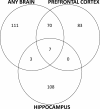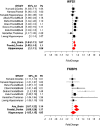Systematic review of genome-wide gene expression studies of bipolar disorder
- PMID: 23945090
- PMCID: PMC3765828
- DOI: 10.1186/1471-244X-13-213
Systematic review of genome-wide gene expression studies of bipolar disorder
Abstract
Background: Numerous genome-wide gene expression studies of bipolar disorder (BP) have been carried out. These studies are heterogeneous, underpowered and use overlapping samples. We conducted a systematic review of these studies to synthesize the current findings.
Methods: We identified all genome-wide gene expression studies on BP in humans. We then carried out a quantitative mega-analysis of studies done with post-mortem brain tissue. We obtained raw data from each study and used standardized procedures to process and analyze the data. We then combined the data and conducted three separate mega-analyses on samples from 1) any region of the brain (9 studies); 2) the prefrontal cortex (PFC) (6 studies); and 3) the hippocampus (2 studies). To minimize heterogeneity across studies, we focused primarily on the most numerous, recent and comprehensive studies.
Results: A total of 30 genome-wide gene expression studies of BP done with blood or brain tissue were identified. We included 10 studies with data on 211 microarrays on 57 unique BP cases and 229 microarrays on 60 unique controls in the quantitative mega-analysis. A total of 382 genes were identified as significantly differentially expressed by the three analyses. Eleven genes survived correction for multiple testing with a q-value < 0.05 in the PFC. Among these were FKBP5 and WFS1, which have been previously implicated in mood disorders. Pathway analyses suggested a role for metallothionein proteins, MAP Kinase phosphotases, and neuropeptides.
Conclusion: We provided an up-to-date summary of results from gene expression studies of the brain in BP. Our analyses focused on the highest quality data available and provided results by brain region so that similarities and differences can be examined relative to disease status. The results are available for closer inspection on-line at Metamoodics [http://metamoodics.igm.jhmi.edu/], where investigators can look up any genes of interest and view the current results in their genomic context and in relation to leading findings from other genomic experiments in bipolar disorder.
Figures




References
-
- Weissman MM, Bland RC, Canino GJ, Faravelli C, Greenwald S, Hwu HG, Joyce PR, Karam EG, Lee CK, Lellouch J, Lepine JP, Newman SC, Rubio-Stipec M, Wells JE, Wickramaratne PJ, Wittchen H, Yeh EK. Cross-national epidemiology of major depression and bipolar disorder. JAMA. 1996;276(4):293–299. doi: 10.1001/jama.1996.03540040037030. - DOI - PubMed
-
- Bunney WE, Bunney BG, Vawter MP, Tomita H, Li J, Evans SJ, Choudary PV, Myers RM, Jones EG, Watson SJ, Akil H. Microarray technology: a review of new strategies to discover candidate vulnerability genes in psychiatric disorders. Am J Psychiatry. 2003;160(4):657–666. doi: 10.1176/appi.ajp.160.4.657. - DOI - PubMed
Publication types
MeSH terms
Grants and funding
LinkOut - more resources
Full Text Sources
Other Literature Sources
Medical
Miscellaneous

